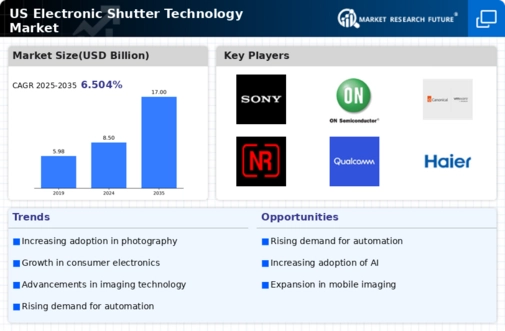Emergence of Smart Surveillance Systems
The electronic shutter-technology market is being propelled by the emergence of smart surveillance systems that leverage advanced imaging technologies. With the increasing emphasis on security and safety, organizations are investing in sophisticated surveillance solutions that require high-performance electronic shutters. The market for smart surveillance is projected to grow at a CAGR of 15% from 2025 to 2030, reflecting a heightened focus on security measures. Electronic shutters play a crucial role in enhancing the performance of these systems, enabling clear image capture in varying lighting conditions. This trend indicates a promising future for the electronic shutter-technology market as it aligns with the growing demand for intelligent security solutions.
Advancements in Automotive Imaging Systems
The electronic shutter-technology market is witnessing growth driven by advancements in automotive imaging systems. This growth is particularly notable with the rise of autonomous vehicles.. As the automotive industry increasingly incorporates advanced driver-assistance systems (ADAS), the need for high-quality imaging solutions becomes paramount. Electronic shutters are essential for capturing clear images in real-time, which is critical for the functionality of these systems. The automotive imaging market is expected to reach $30 billion by 2027, highlighting the potential for electronic shutter technology to play a vital role in enhancing vehicle safety and performance. This trend suggests a strong correlation between automotive innovations and the electronic shutter-technology market.
Growing Adoption of High-Resolution Imaging
The electronic shutter-technology market is experiencing a notable surge in demand due to the growing adoption of high-resolution imaging systems across various sectors. Industries such as healthcare, automotive, and security are increasingly utilizing high-resolution cameras that require advanced shutter technology to capture detailed images. This trend is particularly evident in the medical imaging sector, where precision is paramount. The market for high-resolution imaging is projected to reach approximately $20 billion by 2026., indicating a robust growth trajectory. As a result, manufacturers are compelled to innovate and integrate electronic shutter technology to meet the evolving needs of these industries, thereby driving the overall market forward.
Rising Demand for Professional Video Production
The electronic shutter-technology market is significantly impacted by the rising demand for professional video production, particularly in the entertainment and media sectors. As content creators seek to produce high-quality video content, the need for advanced shutter technology becomes increasingly apparent. Electronic shutters facilitate smoother motion capture and improved image quality, which are essential for professional videography. The video production market is projected to grow to $50 billion by 2026, indicating a robust demand for innovative imaging solutions. This trend suggests that the electronic shutter-technology market will continue to thrive as it aligns with the evolving needs of video professionals.
Integration of Electronic Shutters in Consumer Electronics
The electronic shutter-technology market is significantly influenced by the integration of electronic shutters in consumer electronics, particularly in smartphones and digital cameras. As consumers demand devices with enhanced photographic capabilities, manufacturers are increasingly incorporating electronic shutter technology to improve image quality and reduce motion blur. In 2025, it is estimated that the smartphone market alone will account for over $400 billion, with a substantial portion attributed to camera features. This trend suggests that the electronic shutter-technology market will continue to expand as consumer electronics evolve, necessitating advanced shutter solutions to cater to the growing expectations of users.
















Leave a Comment